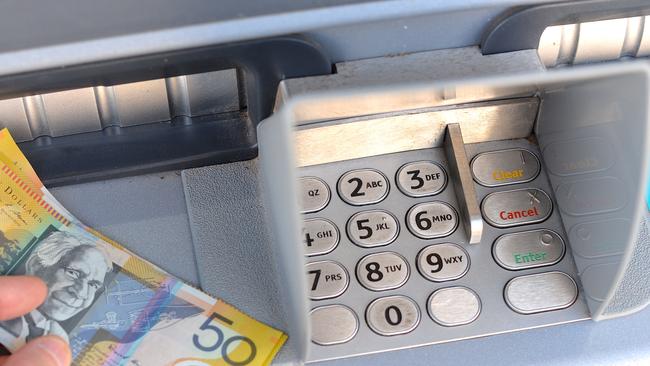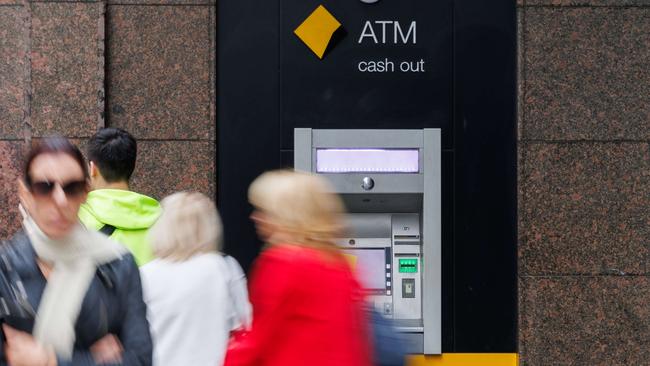The uncertain future of cash in Australia as access reduces, sparking anger among advocates
The ability to get and use cash is getting harder, prompting concerns that physical money faces an uncertain future in Australia – and that’s cause for concern.
Banking
Don't miss out on the headlines from Banking. Followed categories will be added to My News.
The number of bank branches and ATM terminals across the country has halved in the past seven years, as access to cash becomes harder and harder.
The official line from lenders is that demand for cash has waned, and so the number of physical banks and withdrawal machines is lower than in the past.
But some cash advocates dispute these claims, saying the official data doesn’t demonstrate a dramatic fall in consumer trends.

Jason Boyce from the campaign group Cash Welcome, which lobbies for the supply and acceptance of cash, said Australians are more in love with physical money than ever.
Each day across the country, about a million withdrawals are made from an ATM, and that figure has remained largely steady in recent years.
At the same time, the total value of cash in existence has stayed elevated and even risen sharply over the past few months, official data shows.
In all, Mr Boyce said that “cash has trended up in 2024”, adding: “The banks have been withdrawing cash access, but this is not consumer-led.”
“The Reserve Bank numbers tell the truth. Cash is going nowhere. You will give your children a pineapple [colloquialism for $50 note] in a Christmas card in 50 years.”
That’s only true to an extent, Chris Vasantkumar, a lecturer at Macquarie University’s School of Social Sciences, said.

“If we’re just talking about cash as a medium of exchange, then demand has absolutely fallen,” Dr Vasantkumar said.
“This usage has been in decline for years and continued to decline during the pandemic, with the total percentage of economic transactions that cash accounted for slipping from 69 per cent in 2007 to 13 per cent in late 2022. And it has only continued to decline since.”
But there is another ‘use’ of cash that’s worth considering – one that’s less discussed and harder to do away with.
“For many Australians, cash provides a sense of security during uncertain times that digital currencies can struggle to replace. Unlike electronic payment infrastructures, cash never ‘goes down’.
“And this is cash used not as a medium of exchange but as a store of value. This way of holding onto cash exploded during the pandemic when the amount of cash out in the world – not really so much in circulation as under people’s mattresses – reached new heights.”
So, while circulation in the economy and use for transactions is down, demand “is a different matter entirely”, Dr Vasantkumar said.
In the short- to midterm, he doesn’t see cash facing extinction.
“Where things start to get trickier is when you start to get past the next few years,” he cautioned.
Access to cash vanishing
If trends in banking operations continue, that future Mr Boyce imagines will be less and less likely to play.
The total number of bank-owned branches and ATMs has halved in seven years from 19,508 to 8,836 as of June 30, 2024.
In the past financial year alone, more than 200 bank branches have disappeared.
Westpac shuttered 33 branches across the country, or 11 per cent of physical footprint. NAB closed 53, CBA dumped 32, and ANZ got rid of 39.
And the total number of ATM terminals across Australia has collapsed by about 2000 in two years.

Finance expert Associate Professor Lee Smales from The University of Western Australia said many of the 2000 bank branches to close since 2017 were in rural and regional areas.
“Demographic changes and population decline in rural areas, a shift to digital banking and a continued fall in cash use all mean there is simply far less foot traffic,” Dr Smales wrote in analysis for The Conversation.
“Branches themselves are costly to maintain. In addition to rent, wages and security costs, it is expensive to move cash around the country – often prohibitively so for the more remote reaches of Australia.”
The role of armoured trucks
An interesting phenomenon that has impacted the viability of branches and ATMs concerns the armoured trucks that transports cash, Dr Vasantkumar said.
That distribution system is the “achilles heel of cash”, he said.
“It’s a somewhat ungainly public-private hybrid in which Armaguard, a subsidiary of the trucking company Linfox, plays a key role in getting cash to the banks and businesses that need it.
“Unfortunately, the decrease in cash use combined with the increased demand for cash that doesn’t end up circulating but tends sit under people’s metaphorical mattresses, has made it unprofitable to be in the cash-handling business.
“That has led to Armaguard having to be bailed out financially to stay in business. Right now, it is unclear just how sustainable this. Only time will tell if things will have to change more fundamentally for cash distribution to continue.
“Will some customers need to pay more to access cash? Will cash distribution be taken over by the government? We don’t really know, so in this sense, in the medium term and beyond, the future of cash in Australia is quite uncertain.”
The harm of reduced access
The cost of banks shutting up shop can be “significant social and economic impacts” on those communities, which are left disadvantaged when branches disappear.
“Of particular concern are vulnerable groups who may lack reliable transportation options or adequate internet access,” Dr Smales said.
“Losing a local banking presence can also have serious impacts on small businesses. Credit access is constrained if credit assessors based in urban areas fail to understand the needs of rural businesses.
“Some businesses are highly dependent on cash and need access to branches to manage their cash ‘float’, used for providing change and covering minor expenses.”
For businesses in remote areas that don’t have access to EFTPOS terminals, often because network access is unstable or unreliable, a lack of cash can hurt, he said.
Chasing more and more dollars
In the 2023-24 financial year, Australia’s big four banks recorded a combined profit after tax of $29.9 billion.
The country’s banking sector is one of the most profitable in the world, and in seeking to maintain and grow that enviable position, it seems every dollar counts.
The news in December that financial giant CBA was preparing to slug some of its customer $3 each time they wanted to take money out of their accounts was met with fury.
Bizarrely, the bank’s chief executive Matt Comyn claimed in an interview that the first he knew of the controversial move – described by the government as the “worst Christmas present ever” – was via media reports.
“I was surprised and disappointed to see that change go out,” Mr Comyn told The Australian Financial Review.
The bank has since apologised and put the fee on ice.

It’s not just big banks shifting away from cash, with a number of small businesses also refusing to accept it for cost reasons.
Steve Worthington, an adjunct professor at Swinburne University of Technology, said some businesses don’t like cash for good reasons.
“While cash transactions don’t come with a surcharge fee like bank cards, they do carry a wide range of other hidden costs,” Dr Worthington wrote for The Conversation.
“Businesses typically need to keep a ‘float’ of cash in their tills overnight, so that next day’s early customers can be given change if needed. This float needs to be regularly updated and rebalanced with appropriate currency so the correct change can always be given.
“Businesses also have to make sure no cash goes missing during their opening hours, count their cash take at the end of each day, make sure it is secure on their premises, and make periodic physical deposits into their bank account.
“Both maintaining a float and making deposits can involve unpredictable trips to a bank branch or post office throughout the week.”
Digital banking ‘boom’ underway
New data released at the start of December showed what the Australian Banking Association (ABA) has described as a “digital boom”.
The Reserve Bank of Australia figures for October show there were 500 million payments made via mobile walls in the month, totalling more than $20 billion.
ABA chief executive Anna Bligh said the numbers show Aussies are embracing more convenient digital payment options.
“Australians have always been at the forefront of adopting new digital technologies, and these latest figures show that banking is no exception,” Ms Bligh said.
“This massive surge in mobile wallets demonstrates a clear shift towards digital payment solutions, reflecting the evolving preferences of consumers for faster and more secure payment options.
“Go back a decade, and almost no one was making a digital wallet payment. Now we’re seeing over half a billion payments being made with mobile wallets in just one month.”

The overwhelming majority of bank transactions now occur digitally.
In late 2022, the Reserve Bank released its sixth triennial Consumer Payments Survey, examining 13,000 transactions made by a representative sample of 1000 people.
The results suggest that in just three years, the share of cash payments halved from 32 per cent of all in-person transactions to just 16 per cent.
“If one considers all payments, including online payments, cash payments made up 13 per cent by number and around eight per cent by value in 2022,” the RBA said.
“While cash was used less across payments of all sizes, the decline was particularly pronounced for smaller-sized payments. Indeed, the share of payments under $10 made with cash nearly halved over the three years to 2022 … (while) cash use for higher value transactions also continued to decline, although at a slower pace.”
Carrot and stick approach considered
The Federal Government has recognised the potential consequences of a reduce supply of cash and is taking steps to ensure it remains available.
Legislation was recently passed requiring banks as well as businesses in certain yet-to-be-determined industries to accept and handle cash in everyday transactions. It’s expected small businesses will be exempt from the mandate.
As well as a mandate on cash, Treasury is also examining a levy on banks to support regional services.
“Under the proposal, the levy paid by each bank would depend on the number of regional branches and ATMs it maintained, relative to its household deposits,” Dr Smales said.
Early estimates suggest banks with large regional presences would benefit handsomely from such a scheme.
For example, The Australian Financial Review reported that country focused players like Bendigo Bank could bag about $200 million per year, while those who’ve abandoned the bush, such as Westpac, in line to cough up $100 million.

Such a levy scheme isn’t common in too many places globally.
However, other countries grappling with the challenge of collapsing banking services in rural and remote areas have tried other policy approaches.
“India has experimented with mandates to maintain branch networks in smaller towns and rural areas,” Dr Smales said.
“In the US, the Community Reinvestment Act requires banks to meet the needs of regional communities, otherwise they face limits on expansion.”
In South Africa, a combination of mandated services and incentives see banks earn points under a formal economic inclusion framework, he added.
“In Canada and the UK, banks are required to consult with communities before closing branches and must provide alternatives, such as mobile banking.”
Another idea is to expand the existing Bank@Post initiative offered at Australia Post, which allows people to access basic in-person services.
“In consultation with communities, expanding the Bank@Post program could be one of the most viable ways to support regional banking into the future,” Dr Smales said.
“Expanding banking services could further offer a win-win for Australia Post. Its own branches are also dealing with lower foot-traffic as fewer letters are sent.”
Originally published as The uncertain future of cash in Australia as access reduces, sparking anger among advocates





